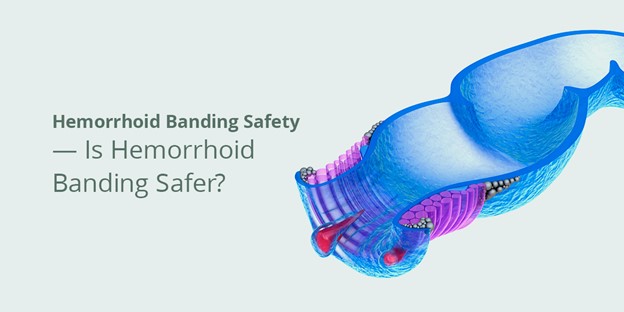
Is Hemorrhoid Banding Safer?
When thinking about choosing hemorrhoid banding as a treatment for your hemorrhoids, there are always a million questions that run through one’s head:
- Will it hurt?
- How much work will I miss?
- Will it hurt?
- How long will it take?
- Will it hurt?
One of the most common questions is whether banding is one of the safer treatment options available. If you were to ask a doctor, in short, he’d probably say yes, but if you’re doing some comparison shopping and are wondering if banding is safer than other treatments, you might like a more specific answer. Fortunately, we’ve got you covered.
What Other Hemorrhoid Treatment Options Do You Have? Is Hemorrhoid Banding a Safer Option?
When seeking a safe hemorrhoid treatment, you want to understand all your options. To help you make that choice, consider these hemorrhoid treatments and how they compare.
How Hemorrhoid Banding Works
Before comparing the safety of hemorrhoid banding with other treatment options, you first need to know how hemorrhoid banding works. Hemorrhoid banding is also referred to as rubber band ligation (RBL). This hemorrhoid removal method was first introduced in the 1950s. Initially, RBL required metal forceps to hold the hemorrhoid in the proper position so a doctor could place a rubber band below the affected vein. As you can imagine, this method caused patients significant discomfort despite its effectiveness. Since then, RBL has greatly improved to be what it is today.
In its most advanced form, RBL uses a suction banding method. Instead of metal forceps, doctors use a single-use ligator called The CRH O’Regan System which is shaped like a syringe to place the rubber band on the problem hemorrhoid. The suction banding method effectively removes Grade I, II and III hemorrhoids with minimal pain and risks.
Hemorrhoid Banding vs. Infrared Coagulation
The answer is somewhat unclear whether hemorrhoid banding is safer than infrared coagulation (IRC). While IRC is a relatively safe and noninvasive procedure with few complications, a prescription for pain medication post-procedure is generally given to patients to deal with some residual pain and swelling in the area.
IRC removes hemorrhoids through the use of infrared light. During an IRC procedure, a doctor uses a small device that generates a concentrated beam of infrared light. The infrared light heats the excess hemorrhoid tissue, which coagulates the blood and creates scar tissue. The scar tissue cuts off blood supply to the hemorrhoid, and the excess tissue eventually shrivels, dies and falls off.
IRC rivals hemorrhoid banding in terms of safety, but it is not as effective. Whereas hemorrhoid banding can effectively treat Grade I, II and III hemorrhoids, IRC can only treat Grade I and II hemorrhoids. Furthermore, IRC has higher recurrence rates and requires more treatment sessions than hemorrhoid banding.
Hemorrhoid Banding vs. Sclerotherapy
Hemorrhoid banding is safer, less painful, faster and more effective than sclerotherapy. Sclerotherapy is a fairly noninvasive treatment where a doctor injects a chemical to harden the surrounding tissue and reduce blood flow to the hemorrhoid. After the blood flow has been cut off, the hemorrhoid dies and falls off about a week later. However, patients often need several treatments before the tissue has hardened enough.
Sclerotherapy is relatively safe but comes with several risks. The most common side effects are pain, redness and inflammation. More serious complications can come from injecting too much of the chemical, injecting it too deeply or injecting it directly into a vein. Sclerotherapy can also cause trouble urinating, prostate inflammation and, in rare cases, impotence or deep vein thrombosis (DVT) if the hemorrhoid vein develops a blood clot that moves elsewhere.
Hemorrhoid Banding vs. Stapled Hemorrhoidectomy
To put it plainly, the answer is yes, hemorrhoidal banding is a safer treatment than a stapled hemorrhoidectomy. This often painful procedure can have patients out of work for up to 10 days and almost always requires a pain medication prescription post-procedure.
Stapled hemorrhoidectomies require general or local anesthesia so the patient does not experience pain during the procedure. After giving the patient anesthesia, the doctor inserts a proctoscope into the anus. A proctoscope is a thin, flexible tube through which the doctor can insert the needed surgical tools. The main surgical tools involved with a stapled hemorrhoidectomy are a suture and a small stapler. The suture holds the excess tissue in position while the stapler cuts through the affected vein to cut off the blood supply. If you think that sounds painful, you’re correct.
Hemorrhoid Banding vs. Conventional Hemorrhoidectomy
Absolutely and 100%, yes, banding is safer. A conventional hemorrhoidectomy requires the doctor to cut off the affected tissue with a scalpel and then sew up the remaining wound. With the possibility of improperly applied sutures coupled with the high likelihood of infection due to the prevalence of bacteria and microorganisms in the passing stools, there’s much that can go wrong. In addition, conventional hemorrhoidectomy can take people out of work for 10-14 days and always requires pain medication post-procedure.
CRH Hemorrhoid Banding Is the Safest Technology on the Market
Hemorrhoidal banding is one of the safest, least painful and least invasive hemorrhoid removal procedures available. Whether your concern is time spent in procedure or out of work, infection or shoddy technique, or the all-important pain factor, most doctors will agree that rubber band ligation is one of the safest hemorrhoid treatments out there. Find a clinic near you that utilizes the CRH O’Regan hemorrhoid banding system to safely and painlessly remove your hemorrhoids!

